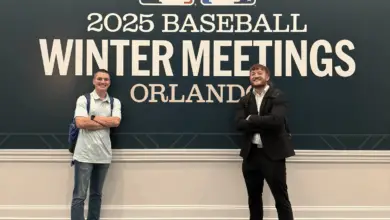
Draft Profiles – Let’s Heat Up Some of Last Year’s Leftovers
The Cubs selected 27 pitchers in last year’s draft, but they were only able to sign 16 of them. Some turned down the Cubs’ offer in order to attend college as freshmen. Five others were draft-eligible college players who returned to school for at least one more season. All were betting on themselves with a goal of improving their future draft position.
Several of those leftover pitchers should be interesting follows throughout the spring, in particular: Trey Cobb (Oklahoma State); Parker Dunshee (Wake Forest); Austin Jones (Wisconsin-Whitewater); Rian Bassett (Clark College); Montana Parsons (Baylor).
Here’s what I said about these five last summer.
Round 12: Trey Cobb (RHP) – Oklahoma State
At 6’1″ and 180, Cobb will be a reliever, but he has starter stuff. This year he appeared in 58.2 innings with a 2.61 ERA while strkiking out 53 and walking only 19. His FB is more of a sinker and he has a plus slider with a changeup that needs a lot of work.
Round 14: Parker Dunshee (RHP) – Wake Forest
The 6’2″, 210 lb righty started 15 games and threw 101.1 innings, striking out 102 with an ERA of 3.20. He is known for his competitiveness on the mound. I think he sticks as a starter.
Round 26: Austin Jones (RHP) – Wisconsin-Whitewater
He was a two-way player who missed all of 2015 and made only 10 appearances this year. In 2014, the 6’2″ righty threw 39.2 innings and K’d 25 with a 2.25 ERA as a freshman.
Round 28: Rian Bassett (RHP) – Clark College
Another big one at 6’5″ and I am not finding much on him yet. I did find some basketball video on him, though, and a couple of bullpen sessions.
Round 30: Montana Parsons (RHP) – San Jacinto JC
In 2016, he had a 2.38 ERA in 13 starts. He struck out 74 in 64.1 IP. Nice projectable frame at 6’3″ and 180 pounds.
Eight months later, I have some additional takes on the five college arms that didn’t sign.
Cobb had the most to gain by going back to college and you have to hand it to him for betting on himself. Going from reliever to starter enhances both his draft position and his wallet. The fact that he’s at a high-profile school will make easy to monitor his progress throughout the spring. Also, he’s a huge Cubs fan.
Parsons is in a similar boat because he will be attending Baylor after moving on from San Jacinto JC. It should be easy to keep an eye on his jump from junior college to Division I, though I’m not quite sure how he will do this year.
Jones is coming off an injury-plagued season and may not pitch as much this year. If the Cubs do redraft him, it’s entirely possible that have to wait until after the 2017 season to make his professional debut. Bassett’s potential debut could be similarly delayed, since it appears he’s more interested in his basketball career for the time being.
Dunshee not signing last years was a mystery to me. Then again, round 14 money is not exactly the most enticing reason to leave college. While he could very easily move up into the top 10 rounds this year, he doesn’t hold as much leverage this year when it comes to contract negotiations.
The Cubs will go to great lengths to unearth starting pitching in this year’s draft, which could very well mean taking another crack at some of these players. If I had to rank them in order of the possibility of being redrafting, Cobb would be at the top of the list, followed by Jones and his reported mid-90’s fastball.
You never know about pitching, though, and anything can happen over the next six months.

